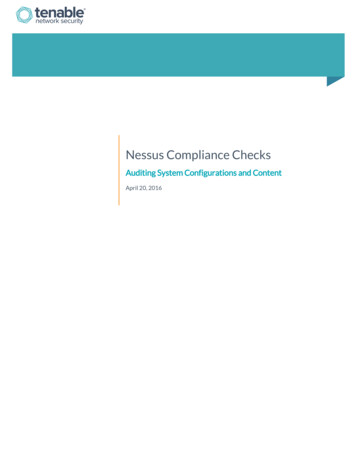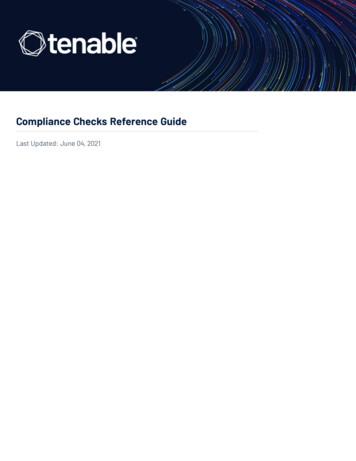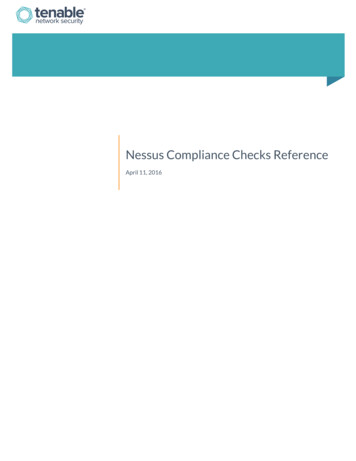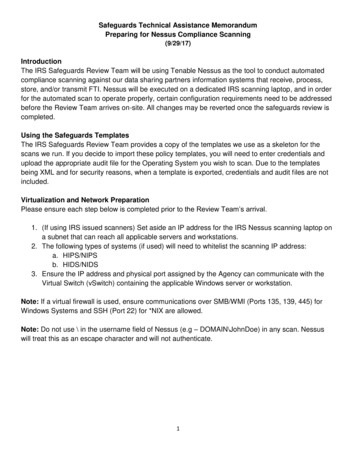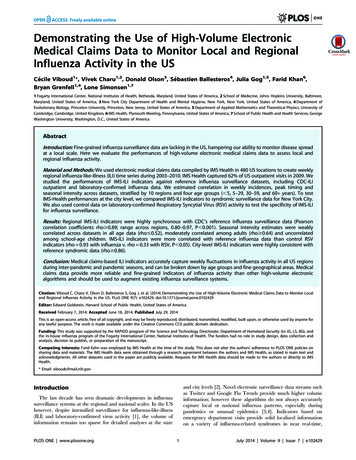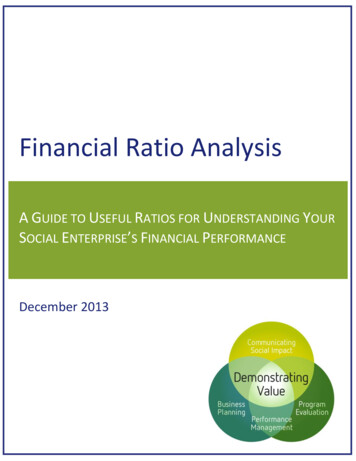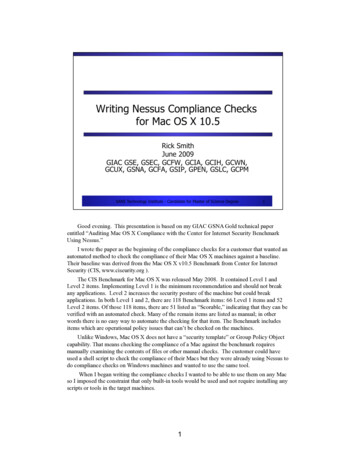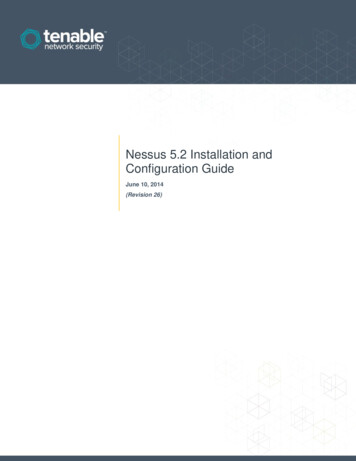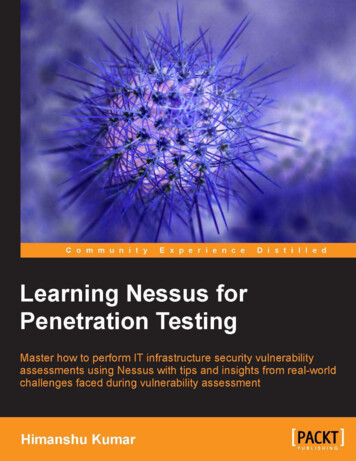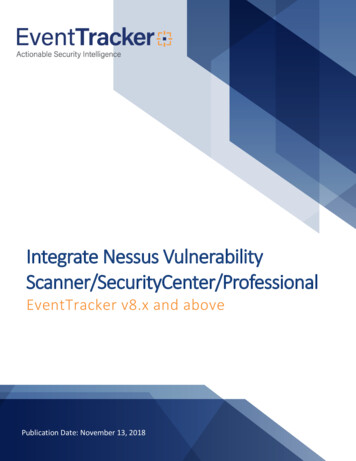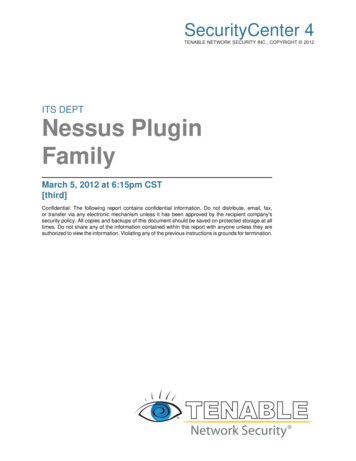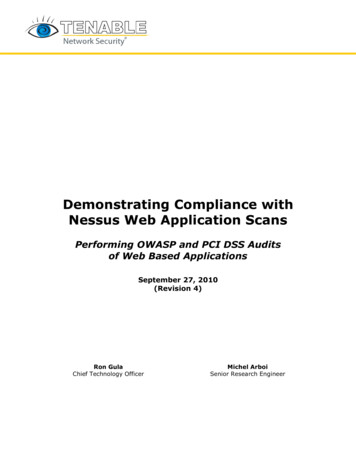
Transcription
Demonstrating Compliance withNessus Web Application ScansPerforming OWASP and PCI DSS Auditsof Web Based ApplicationsSeptember 27, 2010(Revision 4)Ron GulaChief Technology OfficerMichel ArboiSenior Research Engineer
Table of ContentsTABLE OF CONTENTS . 2OVERVIEW . 3OWASP . 52010 OWASP TOP 10 – A1 INJECTION . 62010 OWASP TOP 10 – A2 CROSS-SITE SCRIPTING (XSS) . 72010 OWASP TOP 10 – A3 BROKEN AUTHENTICATION AND SESSION MANAGEMENT . 72010 OWASP TOP 10 – A4 INSECURE DIRECT OBJECT REFERENCES . 82010 OWASP TOP 10 – A5 CROSS-SITE REQUEST FORGERY (CSRF). 92010 OWASP TOP 10 – A6 SECURITY MISCONFIGURATION . 92010 OWASP TOP 10 – A7 INSECURE CRYPTOGRAPHIC STORAGE. 102010 OWASP TOP 10 – A8 FAILURE TO RESTRICT URL ACCESS . 102010 OWASP TOP 10 – A9 INSUFFICIENT TRANSPORT LAYER PROTECTION . 112010 OWASP TOP 10 – A10 UNVALIDATED REDIRECTS AND FORWARDS . 12PCI DSS WEB BASED AUDITS . 12REQUIRED ASV SCANNING COMPONENTS. 13VULNERABILITY REPORTING . 17PERFORMING THE PCI DSS AUDIT. 17PCI DSS 6.5 & 6.6 . 21OWASP 2010 TOP 10 MAPPING FOR PCI DSS 6.5 REQUIREMENTS . 21PERFORMING PCI DSS 6.6 WEB APPLICATION VULNERABILITY ASSESSMENTS WITH NESSUS. 22Web Application Knowledge . 22Manual Verification of Results . 23ADDITIONAL WEB APPLICATION SECURITY MONITORING TECHNOLOGIES . 23PASSIVE WEB SITE DISCOVERY AND AUDITING . 23REAL-TIME LOG, PROCESS AND FILE INTEGRITY MONITORING . 24WEB APPLICATION CONFIGURATION AUDITING. 25DATABASE ACTIVITY MONITORING . 25ABOUT TENABLE NETWORK SECURITY . 26
OverviewTenable Network Security offers solutions to perform vulnerability scanning, passivenetwork monitoring, configuration auditing, real-time log collection and analysis ofenterprise applications and networks. This paper focuses on Tenable’s Nessus vulnerabilityscanner performing web application audits specific to the following standards: OWASP Top 10PCI DSSThis paper reflects standards described by version 1.2 of the Payment Card Industry DataSecurity Standard (PCI DSS) requirements, with specific attention given to demonstratingPCI 6.5 and 6.6 compliance requirements. While Tenable focuses on performing webapplication tests to demonstrate compliance with PCI 6.5, running a web application firewallor performing a source code audit may also fulfill the compliance requirement.In relation to the PCI DSS standard, this paper focuses on how Nessus can be used tosimulate an Internet-based scan from an Authorized Scanning Vendor (ASV). PCI does notallow organizations to self certify; rather, they require an external vulnerability scan froman ASV. A majority of these ASVs make use of the Nessus scanner from Tenable. This paperdemonstrates how to perform internal testing to be better prepared for certification testing.Nessus’ usage for total PCI coverage into configuration audits, antivirus testing and patchtesting, as well as Tenable’s enterprise network monitoring and logging solutions, are notcovered in this paper. They are covered in the “Real-Time PCI Compliance Monitoring” paperreferenced below.Tenable’s Research team continuously updates Nessus’ logic to perform web-based audits.Updates come from research performed by Tenable, feedback from customers such asQualified Security Assessors (QSAs) performing PCI audits, certified ASVs that use Nessusto perform PCI DSS scanning and from regulatory requirements beyond PCI DSS such asthe U.S. government’s DISA STIG standards. As such, Nessus may have more advancedweb-based audits available than what is described in this paper.As of August 2010, searching for the term “CGI Generic” in the list of available NessusProfessionalFeed plugins lists the following 32 Nessus checks:
In addition to these generic checks, Nessus includes thousands of specific vulnerabilitychecks for known security issues in web servers, web applications, web APIs and webmanagement interfaces.The following resources provide more information describing how Tenable can help toperform broader compliance analysis: Tenable Network Security website : http://www.tenable.com/Real-Time FISMA Compliance MonitoringReal-Time Massachusetts Data Security Law MonitoringReal-Time PCI Compliance MonitoringWeb Application Scanning with NessusEach of the covered standards are introduced followed by a brief description of how Nessusweb-based audits can be used to help achieve compliance with the standard. Nessusscanning techniques can be accomplished with Nessus as well as when being managed byTenable’s SecurityCenter. In addition, there is a chapter covering unique web-basedauditing technologies from Tenable including passive network analysis, configurationauditing, database activity monitoring, log analysis and file integrity checking.OWASPTenable Network Security is a proud sponsor of the Open Web Application Security Project(OWASP) and has specifically added technology and checks to the Nessus vulnerabilityscanner to make it easier to find risks identified by this project.OWASP first published web application audit guidelines in 2004, and then updated them in2007 and again in 2010. OWASP guidelines are labeled as risks A1 through A10. A tabledescribing the high-level changes and what is covered between the 2007 and 2010 releasesis shown below:OWASP Top 10 – 2007OWASP Top 10 – 2010A2Injection FlawsA1InjectionA1Cross-Site Scripting (XSS)A2Cross-Site Scripting (XSS)A7Broken Authentication and SessionManagementA3Broken Authentication and SessionManagementA4Insecure Direct Object ReferenceA4Insecure Direct Object ReferencesA5Cross-Site Request Forgery (CSRF)A5Cross-Site Request Forgery (CSRF)Insecure Configuration ManagementA6Security MisconfigurationA8Insecure Cryptographic StorageA7Insecure Cryptographic StorageA10Failure to Restrict URL AccessA8Failure to Restrict URL AccessA9Insecure CommunicationsA9Insufficient Transport LayerProtectionnot in Top 10 – 2007A10Unvalidated Redirects and ForwardsA3Malicious File Executiondropped from Top 10 – 2010
A6Information Leakage and ImproperError Handlingdropped from Top 10 - 2010Each of the OWASP Top 10 risks identified in both the 2010 and 2007 recommendations arecovered below. Each section includes a short discussion on how Nessus’ web applicationtests or vulnerability scanning techniques can be used to identify OWASP risks.2010 OWASP Top 10 – A1 InjectionWhen user input is interpreted by a web application, it may result in execution of code by aback-end process. Common examples of this include: SQL injection – user-controlled data results in arbitrary SQL statements beingexecuted by a backend databaseCommand execution – user-controlled data is processed in such a way that users cancause arbitrary system commands to runLDAP injection – user-controlled data is proceeded in an LDAP query resulting inarbitrary commands being executedThere are many other injection points. The basic concept is that user-submitted data is notcleanly processed and is fed directly into an interpreted set of executable code.Nessus tests for many different types of injection attacks including:Nessus A1 InjectionTechniquesDescriptionGeneric SQL InjectionsNessus includes several plugins to test for SQL injectionissues through multiple techniques including: Traditional SQL injectionSQL injection through HTTP cookiesSQL injection through HTTP headersBlind SQL injection (logic)Time-based blind SQL injection2nd order SQL injectionSpecific SQL InjectionsAs of August 2010, Nessus included network and patch auditsfor more than 400 specific SQL injection vulnerabilities forapplications such as Drupal, Joomla and Bugzilla.XPATH InjectionNessus is able to identify XPATH injection security issuesthrough blind SQL injection testing.SSI InjectionNessus includes two generic tests for traditional SSI injectionas well as SSI injection through HTTP headers.Command ExecutionNessus includes two generic tests for command execution.The first performs basic parameter pollution to look forcommand execution and the second one performs timebased attacks to detect command execution.
In addition to the tests that specifically deal with injection, Nessus’ cross-site scripting(XSS) checks, covered in the next section, also make use of a variety of “injectableparameters”.2010 OWASP Top 10 – A2 Cross-Site Scripting (XSS)Cross-site scripting results from having user-submitted data rendered to other users in anunfiltered manner, which can result in executing hostile or misleading code in the user’s webbrowser.1OWASP defines three types of XSS issues; stored, reflected and DOM.Stored XSS results from submitting user data to a database or back-end process thatstores the data before rendering it for other users. A typical example would be a web-baseddiscussion group where a user’s answer or comment is displayed for all other users. Thiscomment could have unescaped HTML or JavaScript code in it.Reflected XSS attacks use a malicious link, rendered in email or on a web server, to sendusers to a vulnerable web server to exploit or attempt to exploit the browser. When the URLis processed, it immediately renders the HTML or JavaScript to the user who clicked on thelink. The nature of the attack is based on the URL appearing to be trusted or utilize a webserver that is trusted by the user.DOM-based XSS attacks result from using content that modifies the Document ObjectModel (DOM) environment of a victim’s web browser. It is similar to a reflected XSS attackin that a malicious URL can be sent to a potential victim. However, the content is executedwithin the browser as compared to malicious rendering of content on a web server with areflected attack.The most severe form of XSS attacks results in the disclosure of a user’s session cookie orauthenticated credentials that results in having the account taken over. XSS attacks havealso been used to implement a keylogger or conduct other activities that are not intendedby the user.Tenable has implemented multiple Nessus plugins to focus on the detection of mostmethods for reflected XSS attacks. Script #42425, “CGI Generic Cross-Site ScriptingVulnerability (persistent)”, will also identify stored XSS issues.Tenable has also implemented two Nessus plugins (#47830 – CGI Generic InjectableParameter Weakness; #49067 – CGI Generic HTML Injections (quick test)) that arespecifically designed to rapidly identify parameters for XSS testing.2010 OWASP Top 10 – A3 Broken Authentication and SessionManagementWeb sites that have security issues may permit users to exploit a vulnerability that allowsthem to impersonate, steal the credentials or impersonate another user on the web1The “X” in XSS stands for “cross” and is used instead of CSS to differentiate it from acommonly used HTML initialism for “Cascading Style Sheet”.
application. The OWASP project asks seven questions to determine if an application’sauthentication or session management is potentially vulnerable:OWASP A3 QuestionsNessus Audit TechniqueAre credentials alwaysprotected when storedusing hashing orencryption?Nessus checks that HTTP authentication occurs over TLSand reports accordingly. Cookies are displayed, including alltheir attributes. Session cookies are checked againstdisclosure (e.g., do they have “secure” or “HttpOnly”attributes? Are they transmitted over HTTPS?)Can credentials be guessedor overwritten throughweak account managementfunctions?Nessus users can leverage the Hydra brute force guessingtool to test for weak passwords. Nessus also includesseveral checks for common default or backdoor accounts inweb applications. For applications that use theauthentication features of Apache or IIS, Tenable offersmany different configuration audit policies to help test theconfiguration of these servers.Are session IDs exposed inthe URL?Nessus does not currently implement logic to genericallycheck for session IDs. Nessus does check for a variety ofsession ID vulnerabilities in known applications and alsotests for session ID randomness.Are session IDs vulnerableto session fixation attacks?Nessus uses multiple methods to test for this issueincluding cookie injection and manipulation.Do session IDs timeout andcan users log out?Tenable recommends that this test be performed manually,although Nessus scan preferences support the concept of are-authentication delay that can be set arbitrarily low tosee if a session can be forced to time out.Are session IDs rotatedafter successful login?Nessus has a plugin that tests session fixation as well asseveral other checks to enumerate all session IDs.Are passwords, session IDsand other credentials sentonly over TLS connections?Nessus checks that HTTP authentication occurs over TLSand reports accordingly.2010 OWASP Top 10 – A4 Insecure Direct Object ReferencesInsecure direct object references allow authorized users to change a parameter and simplyaccess data regardless of authorization. For example, a poorly written web application mayhave a customer ID value. An authorized attacker may change their customer ID to anothervalue to gain access to a different user’s account information. Guessing multiple IDs couldallow an attacker to enumerate potentially sensitive data of every user of the application.OWASP recommends code reviews to see if an application enforces indirect and directreferences. OWASP also notes that automated scanners do not contain the logic todifferentiate sensitive data on a typical complex web application. Despite that, Tenable feelsthere are several types of audits performed by Nessus that impact this OWASP risk:
Most direct object references are the result of common weaknesses such as pathtraversal, SQL injections, local file injections and the dozens of other webapplications tests performed by Nessus.The 2nd order non-blind SQL injection tests performed by Nessus can identify specificSQL tables.Scripts #44134 (CGI Generic Unseen Parameters Discovery) and #40773 (WebApplication Potentially Sensitive Parameter Detection) will report potentiallydangerous CGI parameters.2010 OWASP Top 10 – A5 Cross-Site Request Forgery (CSRF)This web application weakness leverages image tags, XSS and other techniques to trick anauthenticated user to a sensitive site into submitting a request that does somethingpotentially damaging with the user’s credentials. For example, consider a web applicationthat automatically posts a message to Twitter but requires a user to authenticate to theapplication. If the URL method for posting the message was known ahead of time, anattacker could craft a URL with their desired message and send it to the targeted user viaXSS or embedded in an image tag. If the user clicks on the URL, their authenticated statewith the application would process the URL and send the attacker’s message to Twitter.There have been many examples of using CSRF to reset passwords, purchase products,generate Google AdWord hits and more.There are multiple Nessus audits that are relevant to help ensure CSRF vulnerabilities arenot exploited on your web application: Testing for XSS vulnerabilities with Nessus can ensure that these may not be used toperform CSRF attacks. Although not necessary to perform a CSRF attack, XSSvulnerabilities allow token-based CSRF defenses to be defeated.Nessus plugin #47832 performs “On Site Request Forgery Vulnerability” testing. Thisis a narrower form of CSRF attack testing.Five specific tests detect CSRF in known web applications.2010 OWASP Top 10 – A6 Security MisconfigurationThere are many types of vulnerabilities that can exist in the framework, operating systemand web server application. A security misconfiguration that results in an exploitablevulnerability could be the result of missing patches or software configuration settings.The OWASP project outlines five questions for performing an assessment of this riskcategory.OWASP A6 QuestionsNessus Audit TechniqueDo you have a process for keeping allyour software up to date?Nessus credentialed audits test for missingpatches in the OS, web server, libraries such asPHP and SQL database. Nessus also has checks tosee if a running service has been manuallyinstalled and not part of the software inventorythat could indicate manually compiled web ordatabase daemons.
Is everything unnecessary disabled,removed or not installed (e.g., ports,services, pages, accounts,privileges)?Nessus vulnerability scans and credentialed auditsidentify all open ports. Manual inspection of theseports can identify unnecessary services andNessus audit policies can be created to alert onunauthorized services as well. Nessus alsoidentifies pages and directory browsing throughweb crawling and this can be manually inspectedto identify new pages.Are default account passwordschanged or disabled?Default accounts and privileges can be testedwith Nessus automatically through dozens ofplugins that test for known default credentials incommon applications. In addition, Nessus scanpolicies can be created and configured to test foradditional credentials.Is your error handling set up toprevent stack traces and other overlyinformative error messages fromleaking?Nessus web application tests perform severaldifferent types of queries that will likely show upas errors in the system logs. Error configurationof the web server and underlying libraries is alsosomething that can be audited with Nessus auditpolicy files.Are the security settings in yourdevelopment frameworks (e.g.,Struts, Spring, ASP.NET) and librariesunderstood and configured properly?Nessus audit policies can be used to test thecontent of configuration files as well as to test thefile integrity of the configuration files to ensurethey have not changed.2010 OWASP Top 10 – A7 Insecure Cryptographic StorageEncryption is used to store and secure sensitive data. Web applications should be designedso that, even if they are compromised, the attacker can only access limited data. Forexample, a database that stores passwords “unsalted” but encrypted might be vulnerable toa short-term brute force attack.Nessus audit policies can be used to search for sensitive data in applications that store datain flat files. Tenable offers audit policies that test for the presence of credit card numbers,customer data and many other types of potentially sensitive information. What is consideredinsecure or sensitive should be determined by the auditor, but it is extremely us
In addition to these generic checks, Nessus includes thousands of specific vulnerability checks for known security issues in web servers, web applications, web APIs and web management interfaces. The following resources provide more information describing how Tenable can help
